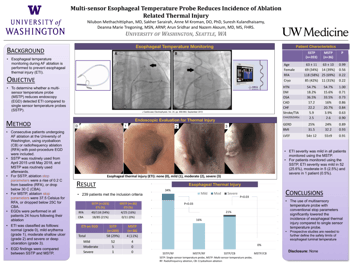
Comparison Between Single- and Multi-Sensor Oesophageal Temperature Probes During Atrial Fibrillation Ablation: Thermodynamic Characteristics
Author Information: Cory M. Tschbrunn, Joshua Silverstein, Tyler Berzin, Ethan Ellis, Alfred E. Buxton, Mark E. Josephson, and Elad Anter
Harvard-Thorndike Electrophysiology Institute, Cardiovascular Division, Beth Israel Deaconess Medical Center, Harvard Medical School, 185 Pilgrim Road, Baker 4, Boston, MA 02215 USA
Center for Advanced Endoscopy, Gastroenterology Division, Beth Israel Deaconness Medical Center, Harvard Medical School, Boston, MA USA
ABSTRACT:
AIMS: Oesophageal temperature monitoring with single-sensor probe (SSP) has a variable ability to predict oesophageal ulceration as a consequence of pulmonary vein isolation (PVI). Multi-sensor self- expandable probes (MSPs) may offer improved thermal monitoring. The objective of this study was to compare the thermodynamic characteristics of both probes during PVI.
METHODS AND RESULTS: This prospective study enrolled 20 patients undergoing index PVI. Ten patients (group A) underwent dual monitoring with SSP and MSP and 10 control patients (group B) were monitored with SSP alone. Time to initial rise (>0.2°C), time to 1.0°C rise, peak temperature, and decay were recorded with each posterior wall lesion (20 W, 198 applications). The operator was blinded to the MSP temperature data and ablation was only interrupted when SSP temperature increased by ≥2°C. All patients underwent endoscopy within 24 h. Initial temperature increase was detected earlier with MSP (13.4 ± 7.5 vs. 30.5 ± 15.4 s; P < 0.001); led to shorter time to 1.0°C rise (18.5 ± 10.1 vs. 32.1 ± 12.0 s; P < 0.001); and higher change in peak temperature (1.6 ± 2.0 vs. 0.60 ± 0.53°C; P < 0.001). Decay time was similar between the probes (146.1 ± 35.3 vs. 150.4 ± 48.4 s; P = 0.89). The incidence of oesophageal ulceration was similar between the Groups A and B (5 and 4, respectively). Multi-sensor self-expandable probe provided greater sensitivity (100 vs. 60%) and similar specificity (60%) for detection of oesophageal ulceration. Five swine underwent oesophageal mapping before and after MSP placement without alteration in size or position.
CONCLUSION: Multi-sensor probes provide a superior thermodynamic profile. Its clinical value in reducing oesophageal injury requires further evaluation.
PUBLICATION INFORMATION:
Published in EP Europace, Volume 17, Issue 6
June 2015
Pages 891-897

.svg)
.svg)
.svg)


